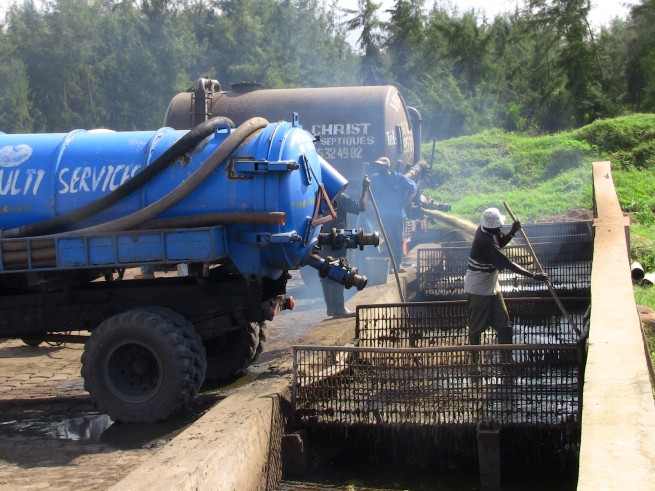UPDATED with report: Second faecal sludge webinar
Jan Spit lets you in on the opportunities for re-use
 © S. Blume/SuSanA Secretariat
© S. Blume/SuSanA Secretariat
Report on the webinar: read the questions that were asked before and during the webinar, and Jan Spit's answers to them:
- I would be interested to look into economic and policy part of this treatment process.
This is a very general question. On anaerobic digestion, an interesting approach has been published on the economic aspects: “Feasibility assessment tool for urban anaerobic digestion in developing countries”, see: http://www.sciencedirect.com/science/article/pii/S0301479713002727
As far as the policy part is concerned, read for instance: “Institutional Frameworks for Faecal Sludge Management” in “Faecal Sludge Management Systems Approach for Implementation and Operation”, see: http://www.unesco-ihe.org/sites/default/files/fsm_book_lr.pdf
-
Application to slum areas (together with simplified sewerage systems).
As far as simplified sewerage is concerned, see: http://documents.worldbank.org/curated/en/1994/05/439130/simplified-sewerage-design-guidelines and: http://www.sswm.info/content/simplified-and-condominal-sewers
-
Can you tell me some opportunities (tenders/call for proposals/donors) to finance septage treatment facilities (mainly the construction of septage treatment plant and the reuse of sludge (energy/biogas) and dry bio-solid as a fertilizer?
Some funding opportunities in the Netherlands are:
- D2B: http://english.rvo.nl/subsidies-programmes/develop2build-d2b
- DRIVE: http://english.rvo.nl/subsidies-programmes/development-related-infrastructure-investment-vehicle-drive
In Germany: KfW: https://www.kfw.de/International-financing/. For innovative funding, look at: http://www.traidwheel.nl/appropriate-finance/Innovative-financing-mechanisms
-
For faecal sludge where disinfectants have been used prior to evacuation, will this affect treatment? I'm about to start a co-compost of faecal and market wastes and I wish to be informed whether this is an issue before I start.
Yes, of course, disinfectants kill the pathogens but also the non-pathogens, so if you intend to co-compost NEVER use disinfectants. The idea of co-composting is that the raised temperatures kill the pathogens, so disinfecting is also an unnecessary action.
-
SFDs define "covered/closed onsite systems" as safe - even in the rare cases where point-water sources are not used in the immediate surrounding of the facilities and sufficient information is available about the groundwater body and soil conditions, what is your opinion about "safe separation of FS from humans"?
For me this is number 1 of my definition of an acceptable and appropriate sanitation facility: “An acceptable and appropriate sanitation facility is a facility that is:
- Environmentally acceptable and safe from a Public Health point of view: excreta (faeces and urine) are handled in such a way that it cannot affect human beings. Excreta are not accessible to flies, mosquitoes, rodents etc. The handling of fresh excreta is avoided. In areas where the people depend on ground water as a resource for drinking water, the groundwater should not be polluted;
- Convenient and safe: there are limited odours and unsightly conditions. The facility is a short walking distance from the house and can be used safely by women, girls and elder people, also at night. The facility is also safe in the sense that people can walk on the subsurface pit without the fear of falling in;
- Simple to operate: the daily operation is minimal and only requires simple and safe routines;
- Sustainable with minimal maintenance: a long technical lifespan and only occasional maintenance, i.e. every 1 or 2 years;
- Upgradable: in the future ‘step-by-step’ (incremental) improvements and extensions are possible;
- Acceptable cost: this does not mean necessarily that the system is cheap. The technology selected should be within the economic and financial reach of the household and (local) government budgets”.
-
A general overview of emergency FS solutions would be great - especially for flooding incidents, because it seems like there are currently a lot of developments in this sub-sector.
See for instance: “WASH in Emergencies Problem Exploration Report Faecal Sludge Management”, see: http://www.elrha.org/wp-content/uploads/2016/01/Faecal-Sludge-Management-WASH-Problem-Exploration-Report.pdf
- FS can be re-used (although I think it should be called "end-used" because technically it has not been used before), in various ways such as combustible, animal feed, soil conditioner...do you know of any case studies where an (up-scaled) viable approach has been realised? (as e.g. Sanergy, Eawag etc. are all not yet fully there...)
http://www.iwmi.cgiar.org/Publications/wle/rrr/resource_recovery_and_reuse-series_2.pdf and of course the proceedings of the FSM2 in Durban: http://www.susana.org/en/resources/conference-materials-2/2012/53-fsm2-durban-south-africa-october-2012. In Kigali, I recently visited Pivot works: http://www.pivotworks.co.
-
What options do any one recommend for the management of Faecal sludge in the Ethiopian context if any one having experiences of the developing world? I am also working in Hawassa University where we have huge teaching University referral Hospital, We do not have experiences of advanced waste water treatment in Ethiopia particularly of Health care (Hospital Wastewater treatment), In addition to lack of experience in wastewater treatment in Ethiopia, our university hospital is based in a very sensitive aquatic environment, that endangers the freshwater lake. Where at the moment we have some indications of pollution from the urban center as well as the effluent from the Hospital. What do you advise Hawassa University to do to solve this urgent wastewater problem? I would also appreciate if any one can suggest me solutions as well as associated impacts if measures are not taken?
There is an interesting experience in Ethiopia as part of the ROSA project. See: http://rosa.boku.ac.at/index.php?option=com_content&task=view&id=28&Itemid=27.
-
I am interested in the possibilities of reuse in agriculture.
This is a very broad question, have a look at: http://www.sswm.info/content/land-application-sludge
-
Does anyone already made compost from latrines faecal sludge, mixed with urban solid waste ? Also, do you think that if well monitored, we could use this compost safely for vegetable production?
Of course, it is a very old custom, but the trick is to do it in a safe way. WHO has published: http://www.who.int/water_sanitation_health/wastewater/Volume4_v2.pdf.
-
What is the destination of the treated faecal sludge?
Can be anything, but usually land application: http://www.sswm.info/content/land-application-sludge
-
How can we integrate and use the treated sludge as a source of irrigation water both in Urban agriculture?
This is not a common approach. Usually treated sludge is used as a soil conditioner, and treated wastewater as source for irrigation.
-
I'm very keen to learn about the approaches in emergency situations.
We have put most things on our website: www.emergencysanitationproject.org. But of course, also have a look at: www.speedkits.eu and: http://www.elrha.org/hif/home/
-
Issue of FSM in Mediterranean carstic coastal areas.
This is a very difficult one, I would certainly advocate to use “faecal sludge” tight solutions: Labaronne has quite a good experience with this: http://www.labaronne-citaf.com/-Waste-water-storage-.html#165
-
What are the latest research question related to treatment of faecal sludge treatment?
For the time being these are elaborated in the HIF Gap analysis: http://www.elrha.org/wp-content/uploads/2015/01/hif_wash_gap_analysis_1.pdf.
-
What are the main challenges to implementing more sustainable, development-focused solutions during an emergency? How has this been tried in different emergency contexts (natural disaster, protracted crisis, etc.)?
The challenges are well established in the Gap Analysis report. It has been tried within the context of the Emergency Sanitation Project and Speedkits.
-
Which additives need to be added to create pellets?
In Kampala AEWAG is trying coffee husks, sawdust, see: http://www.eawag.ch/en/department/sandec/projects/ewm/seek-sludge-to-energy-enterprises-in-kampala/
-
Are the additives expensive?
No, in principle you choose locally available waste products.
-
Period of drying in Kigali? What form of faecal sludge?
4 days, see: http://www.pivotworks.co/updates/
-
How do you know if you can/cannot test the compost for vegetables? Or does it contain heavy metals?
In the Netherlands, there are companies that test the compost. Heavy metals may be there if the compost is a result of co-composting with municipal waste.
-
Youtube clips on black soldier fly:
https://www.youtube.com/watch?v=qX8up2qhTto
https://www.youtube.com/watch?v=m0zlwETN8l0&spfreload=10
-
Link to report of the Boston Consultancy Group: collecting sludge/making pellets.
http://wash.unhcr.org/download/improving-sanitation-in-refugee-camps/
You can listen to the webinar on 'Treatment of faecal sludge' now below this message.
What happens with the piles of sh*t gathering close to every human settlement? There are many ways to treat faecal sludge. Jan spit will discuss different methods of treatment, from traditional- to emergency- to innovative approaches.
This webinar was held at Tuesday February 18th where we could listen to Jan's experiences, and many of you shared their own. The aim of the webinar was to share best practices, to learn, to get to know ánd inspire each other.
Programme:
- Definition of Faecal Sludge Management (FSM)
- Aim of FSM
- Design criteria
- ‘Traditional’ overview
- ESP/S(p)eedkits overview
- Experiences in Malawi
- Discussion per system

